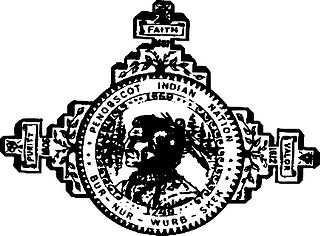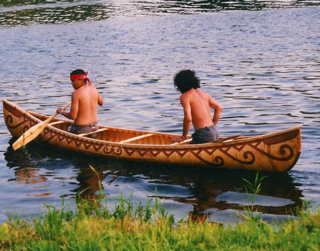
The Abenaki are Indigenous people of the Northeastern Woodlands of Canada and the United States. They are an Algonquian-speaking people and part of the Wabanaki Confederacy. The Eastern Abenaki language was predominantly spoken in Maine, while the Western Abenaki language was spoken in Quebec, Vermont, and New Hampshire.

Falmouth is a town in Cumberland County, Maine, United States. The population was 12,444 at the 2020 census. It is part of the Portland–South Portland–Biddeford, Maine metropolitan statistical area.

Brooksville is a town on Penobscot Bay in Hancock County, Maine, United States. As of the 2020 census, the town population was 935. It contains the villages of North Brooksville, South Brooksville, West Brooksville, Brooksville Corner, and Harborside.

Penobscot Indian Island Reservation is an Indian reservation for the Penobscot Tribe of Maine, a federally recognized tribe of the Penobscot in Penobscot County, Maine, United States, near Old Town. The population was 758 at the 2020 census. The reservation extends for many miles alongside 15 towns and two unorganized territories in a thin string along the Penobscot River, from its base at Indian Island, near Old Town and Milford, northward to the vicinity of East Millinocket, almost entirely in Penobscot County. A small, uninhabited part of the reservation used as a game preserve and hunting and gathering ground is in South Aroostook, Aroostook County, by which it passes along its way northward.

The Penobscot are an Indigenous people in North America from the Northeastern Woodlands region. They are organized as a federally recognized tribe in Maine and as a First Nations band government in the Atlantic provinces and Quebec.

The Passamaquoddy are a Native American/First Nations people who live in northeastern North America. Their traditional homeland, Peskotomuhkatikuk, straddles the Canadian province of New Brunswick and the U.S. state of Maine in a region called Dawnland. They are one of the constituent nations of the Wabanaki Confederacy.

Casco Bay is an inlet of the Gulf of Maine on the southern coast of Maine, New England, United States. Its easternmost approach is Cape Small and its westernmost approach is Two Lights in Cape Elizabeth. The city of Portland sits along its southern edge and the Port of Portland lies within.

Norridgewock was the name of both an Indigenous village and a band of the Abenaki Native Americans/First Nations, an Eastern Algonquian tribe of the United States and Canada. The French of New France called the village Kennebec. The tribe occupied an area in the interior of Maine. During colonial times, this area was territory disputed between British and French colonists, and was set along the claimed western border of Acadia, the western bank of the Kennebec River.

Dummer's War (1722–1725) was a series of battles between the New England Colonies and the Wabanaki Confederacy, who were allied with New France. The eastern theater of the war was located primarily along the border between New England and Acadia in Maine, as well as in Nova Scotia; the western theater was located in northern Massachusetts and Vermont at the border between Canada and New England. During this time, Maine and Vermont were part of Massachusetts.
The Treaty of Casco (1678) was a treaty that brought to a close the war between the Indigenous Dawnland nations and the English settlers. There are no surviving copies of the treaty or its proceedings, so historians use a summary by Jeremy Belknap in his 1784 History of New Hampshire.

Cape Porpoise is a small coastal village in the town of Kennebunkport, Maine, United States, and was the original English settlement of the town. It is located northeast of Dock Square and southwest of Goose Rocks Beach. The village occupies the mainland adjacent to Cape Porpoise Harbor. More than a dozen islands protect the deep natural harbor. The ZIP Code for Cape Porpoise is 04014.

The Wabanaki Confederacy is a North American First Nations and Native American confederation of five principal Eastern Algonquian nations: the Abenaki of St. Francis, Mi'kmaq, Maleceet, Passamaquoddy (Peskotomahkati) and Penobscot.

The Pentagoet Archeological District is a National Historic Landmark District located at the southern edge of the Bagaduce Peninsula in Castine, Maine. It is the site of Fort Pentagoet, a 17th-century fortified trading post established by fur traders of French Acadia. From 1635 to 1654 this site was a center of trade with the local Abenaki, and marked the effective western border of Acadia with New England. From 1654 to 1670 the site was under English control, after which it was returned to France by the Treaty of Breda. The fort was destroyed in 1674 by Dutch raiders. The site was designated a National Historic Landmark in 1993. It is now a public park.
The Northeast Coast campaign was the first major campaign by the French of Queen Anne's War in New England. Alexandre Leneuf de La Vallière de Beaubassin led 500 troops made up of French colonial forces and the Wabanaki Confederacy of Acadia. They attacked English settlements on the coast of present-day Maine between Wells and Casco Bay, burning more than 15 leagues of New England country and killing or capturing more than 150 people. The English colonists protected some of their settlements, but a number of others were destroyed and abandoned. Historian Samuel Drake reported that, "Maine had nearly received her death-blow" as a result of the campaign.
The Northeast Coast campaign (1723) occurred during Father Rale's War from April 19, 1723 – January 28, 1724. In response to the previous year, in which New England attacked the Wabanaki Confederacy at Norridgewock and Penobscot, the Wabanaki Confederacy retaliated by attacking the coast of present-day Maine that was below the Kennebec River, the border of Acadia. They attacked English settlements on the coast of present-day Maine between Berwick and Mount Desert Island. Casco was the principal settlement. The 1723 campaign was so successful along the Maine frontier that Dummer ordered its evacuation to the blockhouses in the spring of 1724.
The Battle of Falmouth was fought at Falmouth, Maine when the Canadiens and Wabanaki Confederacy attacked the English New Casco Fort. The battle was part of the Northeast Coast Campaign (1703) during Queen Anne's War.
Walter Gendall was a 17th-century English sawmill owner in and prominent citizen of North Yarmouth, Massachusetts Bay Colony. He was also a captain in King Philip's War of 1675–1678 and King William's War of 1688–1697. He lost his life in the second conflict. His name is also spelled Walter Gendle in literature.

Pejepscot is a historical settlement first occupied by a subset of the Androscoggin Native Americans known as the Wabanaki. The region encompasses the current towns of Brunswick, Topsham and Harpswell, Maine in Sagadahoc and Cumberland counties and was first settled by English settlers in 1628.

Cape Rosier is a cape on the south central coast of the U.S. state of Maine, extending into the Atlantic Ocean. The peninsula reaches south and westward from the mainland into Penobscot Bay. It constitutes the western part of the town of Brooksville, in Hancock County, cut off from the rest of the town at a narrow neck where Orcutt Harbor extends from Eggemoggin Reach northward, and nearly reaches Smith Cove on the north side of the cape. To the west, it forms a part of the estuary of the Penobscot River. The head of the cape is at 44°18'43.2"N 68°49'36.6"W.
Walter Bagnall was an early settler of the colony of Massachusetts Bay. In 1628, he became the first European immigrant to settle on Richmond Island, off Cape Elizabeth in today's Maine.
















